The stories we tell will determine whether our society declines and self-destructs or whether we can heal and thrive.
Don't wanna be here? Send us removal request.
Text
For Your Beauty

This project was made for EA020 Nature, Culture, Society. We had two weeks from the day it was assigned to the showcase. The assignment was to create an art piece related to an environmental topic, so just incredibly broad. Everybody made something super unique and very cool. I really enjoyed seeing all their work.
Brainstorming ↓
The professor was encouraging, though not requiring, us to engage with the idea of "making the invisible visible." I was also thinking a lot about purity culture and the idea of purity in environmentalism. We had read an excerpt from Alexis Shotwell's book Against Purity where she argues that "purity" is impossible to achieve and dangerous to attempt. "Purity is never made simple. Aspirations to purity, are…misleading ad copy on one level and secret carcinogens as a cell boundary-crossing material reality on another." There is not even such thing as real purity, "there is no primordial state we might wish to get back to, no Eden we have desecrated, no pretoxic body we might uncover..."

Refining the Idea ↓
I came to the idea of sewing a sort of cottagecore dress and attempting to subvert the ideals of purity that exist within that subculture and reveal the hypocrisy present in the way these people present themselves.
Before I talk about cottagecore, I want to say that I did not really go deep into the subculture. I had been exposed to it online before and knew a bit about it and then did some surface level research focused around the look it presents, but I don’t know the nuances of this community and perhaps that is reflected in my analysis of it.
But anyway— Cottagecore is an aesthetic that idealizes rural life. I feel it draws especially from late 19th-century European pastoral life, but it pulls inspiration from multiple places and periods and is not trying to authentically recreate any past style. The aesthetic promotes the ideal of living simply, disconnecting from the internet, being self-sufficient, baking bread, and having traditional feminine and creative hobbies such as embroidery, pottery, painting, baking, etc.
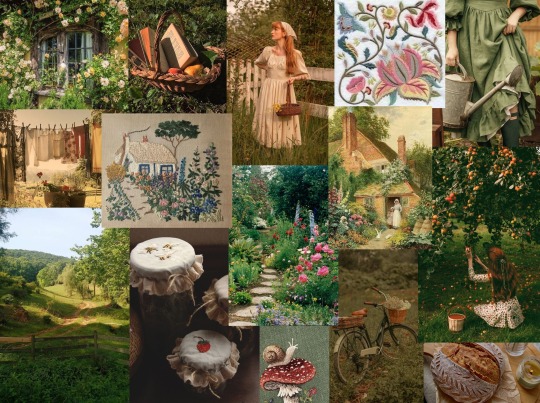
Cottagecore seems to intersect with environmentalist messages, though believe it to be a coincidental byproduct of their want to return to simpler times as opposed to a deliberate want to live or promote a sustainable lifestyle (I'm sure there are people who are interested both in environmentalism and cottagecore and perhaps even picked up on the aesthetic for those environmental reasons, but I presume them to be in an extreme minority). Traditional rural living is more eco-friendly than modern city life: homemade goods, traditional crafts, growing your own food, reducing reliance on consumerism. Consumerism... that's what I'm especially interested when it comes to the cottagecore aesthetic. They idealize a time before rampant consumerism, a time before the internet, a slower, simpler time, just sitting down and reading a book or connecting with your environment. I see a lot of pictures of women collecting wildflowers, picking fruit from their gardens, going on picnics in the rolling countryside. But at the same time, this aesthetic originally gained and has maintained popularity on TikTok. An app that perhaps stands as the antithesis to that type of lifestyle. TikTok is fast-paced and trendy, obsessed with constant engagement and constant consumption. Also ads everywhere! Promoted videos, sponsorships, TikTok shop, undisclosed ads, sometimes it feels like everyone is trying to sell you something.
Look, I like the cottagecore aesthetic. I think it's super cute and, in the current landscape, I can't help but idealize that sort of pastoral living. But engaging in this trend isn't an escape from consumerism. It's driven by consumerism.
Cottagecore is an aesthetic. At its very core, it's about commodification and surface-level adoption. By engaging with it, you are feeding into an industry that exists to shape consumer desires and drive sales. So most people who are interested in this sort of aesthetic aren't really attempting to extricate themselves from our highly consumeristic culture, quite the contrary, they are purchasing products that align only with the image of living a life free from corporate overlords and late-stage capitalism.
Anyway, I've gotten away from the point a little bit. What I was focusing on in this project was the fashion industry. We all know how much fast fashion is ruining the planet and how incredibly exploitative it is.
Here is my extremely quick and condensed summary of ethical problems in the fashion and textile industries:
The fashion and textile industries are major contributors to pollution, resource depletion, and labor exploitation. Industrial monocropping and irrigation deplete soils of nutrients and heavy use of pesticides impacts the quality of the soil and the workers who apply it. Pesticide runoff contaminates water supplies and thus the health of humans, animals, and plants in the area. Even stuff that isn't immediately harmful or toxic accumulates in bodies and magnifies up the food chain. Not to mention just the sheer amount of water that cotton production requires.
Additionally, most fashion brands rely on cheap labor, child labor, and even slave labor in dangerous working conditions particularly in developing countries. These practices violate basic human rights and perpetuate cycles of poverty and exploitation in vulnerable communities.
Here are some links to get you started on further reading if you're interested: Sweatshop Facts — The World Counts; Modern slavery is on the rise. Fashion’s role remains steady — Vogue Business; Fast fashion: an industry built on exploitation — Collective Fashion Justice; The impact of textile production and waste on the environment (infographics) — European Parliament; Tons of water used in cotton production — The World Counts
All of this exploitation of people and Earth's resources contradicts the values of simplicity, authenticity, and connection to nature that cottagecore seems to represent. Perhaps cottagecore was born out of a genuine love and interest in the simple, the homemade, the vintage, and the sustainable, but it has fully been co-opted by commercial interests. Brands have capitalized on its appeal by pumping out mass-produced cottagecore-inspired goods (especially clothing) that not only do not align with those values but fully spit in their face. When purchasing this aesthetic, you are purchasing the idea that you believe in its 'core values.' You are purchasing the illusion of a connection to nature and authenticity while directly supporting practices that undermine those very values.
(I do feel it necessary to point out that there are people that exist who fall into the cottagecore aesthetic but do not engage in the capitalist side of it. However, they are by far not the majority. Like it or not, the aesthetic has been taken over by corporate interest and consumeristic behavior.)
Designing ↓
Cottagecore clothing is very old-world inspired. Milkmaid dresses, prairie dresses, ruffles, light colors, florals, that sort of arena. Because of the time constraint, I decided to incorporate a dress I had already made. A few summers ago I made a milkmaid dress (pattern: Mood Fabrics Anthea Milkmaid Dress). It's like the second real sewing project I did so the construction is kinda wonky, but it has the right sort of top for the look I'm going for, and with my other classwork, I didn't think I'd have time to sew a new top for this project.
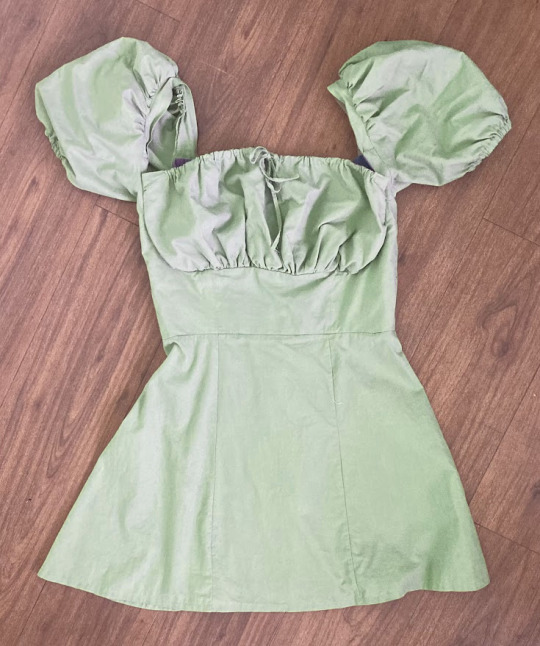
For the skirt, I knew I wanted it to be floor length and was thinking sort of like a prairie dress skirt. I ended up going with another Mood pattern (The Heather Dress) though I really could have drafted it myself and I altered it so much anyway.
Going into this stage I knew I wanted the skirt to tell a story about its production. I was thinking sort of a story map style narrative wrapping around the skirt. I was inspired by story tapestries and children's storybook styles.

You can see more of my thought process and ideas below, but this idea had to be scrapped due to the time limit. There was just no way that I was going to be able to design and execute this whole story map idea in just a few days.
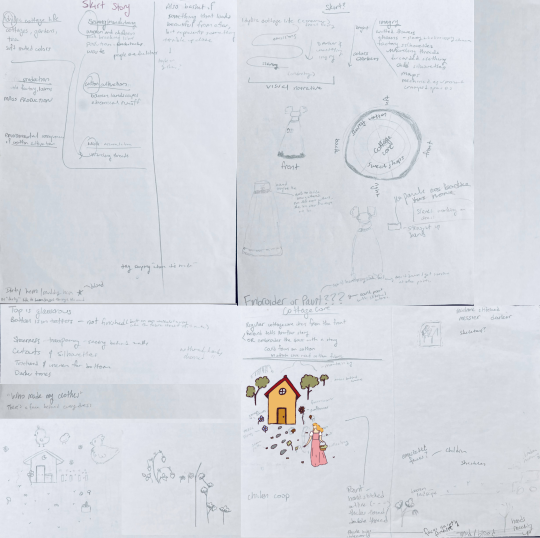
I pivoted to a different idea that you can see started to form on those pages. The idea of having the hem appear to have been dragged through mud or blood.
I really wanted to go with the look of having the hem soaked in blood representing the hidden cost behind beautiful garments. The blood of the human beings who work the cotton fields, who sew your clothes, who toil in the hazardous conditions under which our clothes are produced. A visceral reminder of the very real human suffering that produces innocent-looking clothing.
Now that I have made that aspect of the design the entire thing, I felt I needed to expand it a bit. I wanted hands grasping at you as if begging for help. The desperation and anguish felt by workers subjected to abysmal treatment in their work. Blooded hem and haunting images would contrast the pristine and innocent look of the bodice and upper skirt. The stark juxtaposition between our two positions. Their desperation against our indifference. You could extend a helping hand but choose not to, turning a blind eye to their suffering while enjoying the fruits of their exploitation.
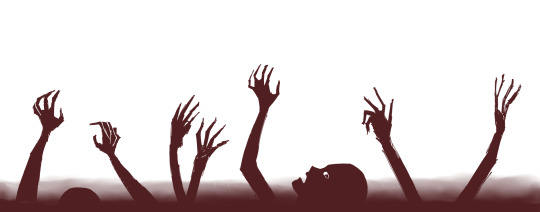
Sewing ↓
I went to thrift stores looking for fabric. Reusing fabric from something else supports the message of the piece, but really my main motivation was that I'm cheap. I was looking for a light-colored fabric that matched the tone and weight of the dress I was using for the bodice. Having to match the bodice made the search more difficult, but luckily I was able to find something that works. For $2.99 I got a slightly stained king top sheet. The color goes surprisingly well with the bodice's shade of green, I think this is the best result I could have hoped for given the parameters.
I used my school's makerspace to sew. The machines are kind of crappy, I had quite a few issues with them which caused it to take longer than I could have done on my machine at home, but the job got done and honestly I'm just glad that I have access to a machine out here at all. The thing I will complain about though is the chalk. Like on one hand, thank you for putting chalk in the sewing makerspace. On the other hand, this room was not stocked by somebody who sews. They have blackboard chalk not tailor's chalk which is totally fine except that they only have colored chalk! I didn't look it up beforehand (which maybe is my fault but also I was using supplies in a sewing room) and it stained my fabric. I thought it would come out in the wash, but no. I don't have anything for laundry here besides detergent and baking soda, so when I go home I'll treat it properly and hopefully that will help.
I needed to lengthen the skirt pattern so it went all the way to the floor and then totally forgot until I had marked and was about to cut the fabric. Whoops. And then I didn't actually measure how much to lengthen it by and just guesstimated it. The main part of the skirt should have been longer and then the bottom panel much shorter. The entire skirt ended up about two inches too long. It drags on the floor much more than I would like it to. I could bring up the hem but I hate hemming skirts so much that I've just let it be.
Another thing about the pattern is that it wants you to gather SO MUCH. From the pictures, I did not anticipate the amount of gathering. It's such a pain, and honestly, I think it looks better with the amount I ended up doing instead of using all of the fabric. The problem is that I didn't realize what was going on until I was too far into the process. It would have been such a pain and cost me precious time to cut the fabric and rework it so there was the 'right' amount of gathering and the panel seams hit at the right place. So the placement of those seams is super wonky. I hoped that in the waves of the skirt they wouldn't be noticeable unless you were looking, but turns out that is not the case. Also this meant that there was all of that extra fabric now in the skirt's back panels. In order to install a zipper, I would have to cut those. But I'd have to cut them exactly the right amount and at the right angle. The skirt was taking much longer than I had planned to sew and at this point, there were only a few days before it was due. I decided screw all that tedious work, I've already done so much of it, I'll just use buttons and let the extra fabric (hopefully) cover up the slit in the skirt in a natural way.

I ran into a second problem with the gathering as well but in the opposite direction. The bottom panel is supposed to be as gathered as the top one but it's just so much fabric. I did technically have enough fabric to have 3 panels the size the pattern called for, but I hate hemming and I had the finished edges of the bedsheet right there and I was so frustrated with sewing at this point so I just cut one panel down the length of it. It turned out to be not enough fabric to gather almost at all. If I didn't have a deadline with this project, the gathering does mean enough to me that I think I would have spent the time to cut another panel and hem the whole thing, but unfortunately, that was not the scenario I was in so I just left it how it was. It doesn't look bad the way it is, I just think the shape of the skirt would have been a little bit better. Another factor to consider though is how that would impact the design on the skirt. I was a little worried about the amount of gathering impacting how well the design translated. So I guess it's good for me that I never had to decide how much gathering I wanted for the shape versus how much I could get away with and the design still be readable.
And then with the buttons!! The makerspace did surprisingly have a buttonhole AND button foot, but for some reason the buttonhole foot didn't really work. I've made them before on my machine at home and I watched a tutorial to make sure I wasn't forgetting something, I have no idea why it didn't work. I never took a picture of the failed attempts, but they were just not buttonholes. Instead, I just made them with a series of zigzag stitches. I mean, that's what the machine is doing with the buttonhole stitch anyway, what I did is just a little bit jankier.
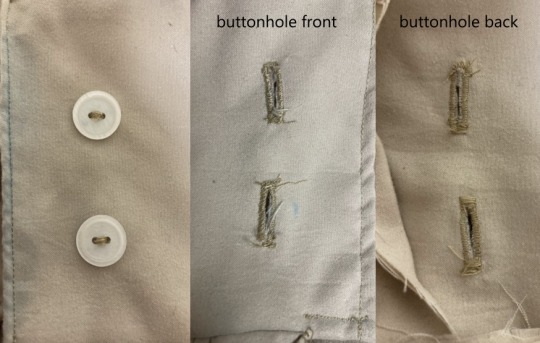
Mudding ↓
I finished sewing the dress two days before the assignment was due which left me only one day to translate the design. I'm really glad I simplified it as much as I did and I still think it does a good job of getting the core message across.
Going into the final day I had to work on this, I was still fully planning on painting it. The original plan was for the design to be in 'blood' not mud. The problem is I don't own any paint and wasn't interested in spending any more money on this assignment. Obviously I first looked in the makerspace, but for some reason they don't have any paint?? I went to a few other spaces I thought might have some I could use but came up empty-handed. So I moved on to plan B. Actually, mud was my mother's idea. She suggested it one time when I was talking to her back in the brainstorming phase. It totally works. Mud is freely and widely available and still reads as very similar to the blood idea, only less shocking. So after dinner (yes, I spent all day searching for paint and trying to come up with an alternative without resorting to dirt), I went out in the pouring rain to some fields behind my college to collect dirt.
One important thing I had forgotten about the dirt around here is how sandy it is. The dirt where I grew up was pretty clay-y, that's what I'm used to, and I had just forgotten that dirt around here isn't like that. It's not like the sandy dirt was any kind of deal-breaker or anything, I just thought (1) rubbing it into the fabric will damage the fibers more than a dirt with more clay content and (2) it's probably gonna leave more little rocks and pieces of sand in it's wake.
But it was fine and also like 9 o'clock the night before it was due so I didn't dwell on it. Problem though, it's dark and raining outside, where am I going to do the dirty work? The answer: just in my dorm. My room had dirt and grit everywhere for like a week afterward.
Applying the mud was actually very easy. I first drew the design on the skirt with a light-colored washable marker and then made a mud slurry and really just slopped it on. On the edges and finer areas, I used a popsicle stick to get a harsher line. I also attempted a bit of an ombre effect going up. It was inconsistent, but I stand by the idea.
I draped my skirt over my floor lamp for this, which was a great idea if I do say so myself. The whole process from when I got home with the dirt to when I finished the skirt was maybe four hours and this was certainly the part I enjoyed the most.
Final Thoughts ↓
In the end, it actually turned out kinda okay. You can see in the pictures that I decided to button it at the front side instead of in the back like how it was originally supposed to be zippered. This means that one of the panel seams is right there in front, so not a fan of that. But overall, I'm happy with it. I took these pictures 6 weeks after I finished it and was pleased with how well the mud lasted. I was worried that because it was so sandy, it wouldn't stick as well to the fabric. It did come off some, as you can see, and if it was something I had worn or otherwise moved around more, it would have been a bigger deal, but as it was, I actually liked the way the dirt faded.
If you care, I got a 91% on the assignment, but it was cos my artist statement sucked not because of my actual piece.
....well, goodbye

February 2024
0 notes
Text
the beginning of boohbah is high art
5 notes
·
View notes
Text
youtube
A documentary made as my final for a course on happiness.
December 2023
0 notes


